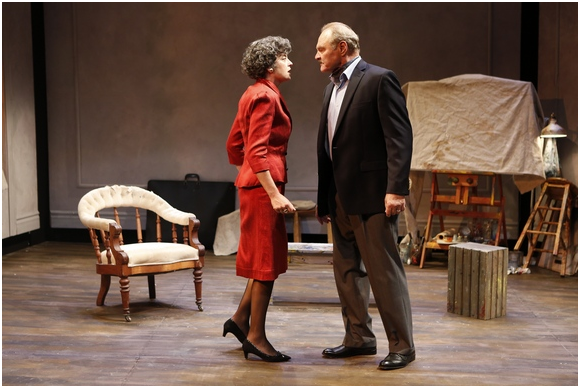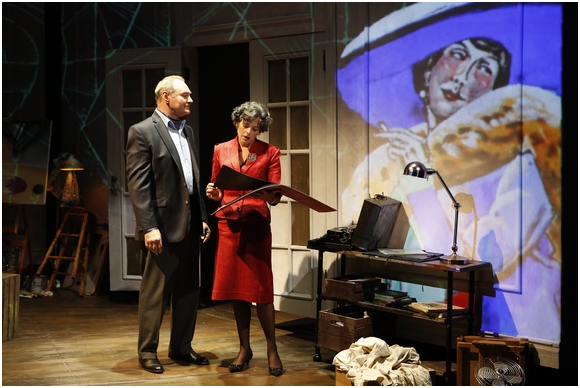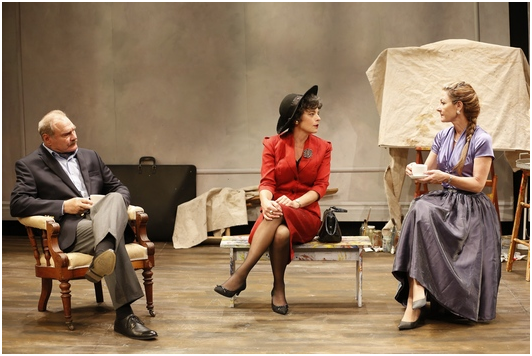Bauer

Stacy Ross as Hilla von Rebay and Sherman Howard
as Rudolf Bauer in a scene from Bauer
(Photo credit: Carol Rosegg)
German painter Rudolf Bauer is probably the most famous artist of whom you have never heard. Once the most famous artist in the world of the non-objectivist school, Bauer’s legacy turned to obscurity due to a series of apparent betrayals. Bauer by Lauren Gunderson (also the 2014 Steinberg/ATCA New Play Award winner for I and
You) rivetingly dramatizes the facts of this story, probably the most famous scandal in modern art history. The play offers a fictional confrontation set in 1953 between Bauer who then lived in Deal, New Jersey, and his former lover and decades-long supporter Hilda Rebay, at that time curator of what was to become the Solomon R. Guggenheim Museum. Now appearing at 59E59 Theaters as part of the inaugural 5A Season, not only is the San Francisco Playhouse production staged by artistic director Bill English brilliantly theatrical, it may just be the best dramatization of that intangible essence which makes up an artist’s vision.
If you saw the recent PBS showing of the 2008 documentary Betrayal: The Life and Art of Rudolf Bauer, you are familiar with the backstory. Artists Bauer and Baroness von Rebay (known as Hilla) met and fell in love in Berlin in 1916. Unfortunately, their tempestuous relationship and the fact that her aristocratic family did not think that he was good enough for her drove them apart. In 1927 she moved to the United States to paint a commissioned portrait of financier Solomon R. Guggenheim and became his artistic advisor and the eventual curator of his Museum of Non-Objectivist Painting, while continuing to champion Bauer’s work. In the meantime, Bauer had become Germany’s most famous artist of what is now called the abstract expressionist school bypassing his mentor the Russian Kandinsky, as well as Klee, Mondrian, and others. Soon after the 1936 Degenerate Art exhibit mounted by the Nazis in Munich, Bauer was arrested for his art which was against Nazi principles as well as for being a traitor to the nation, that is, for having sold paintings to the foreigner Guggenheim.
With a suitcase full of money from Guggenheim, Rebay bought Bauer out of prison and he eventually arrived in the United States during the summer of August 1939 where he lived at Rebay’s Connecticut estate for several months. Rebay brokered a seemingly lucrative contract between Bauer and the Guggenheim Foundation that became the source of all his future troubles. As Bauer’s English was very poor, he counted on Rebay as his translator and that his concerns had been met. According to the terms of the agreement, what he thought was a $300,000 settlement was actually just the annual interest on a trust, and instead of a cash payment for 110 paintings already owned by Guggenheim, he discovered that all of his future output was to belong to the Foundation.

Sherman Howard as Rudy and Stacy
Ross as Hilla in a scene from Bauer
(Photo credit: Carol Rosegg)
The 25-room Guggenheim mansion in Deal, N.J., turned out only to be Bauer’s for life and not his personal property. He was also supposed to be co-curator with Rebay of the planned Solomon R. Guggenheim Museum by the terms of Guggenheim’s will which never happened. Bauer could not get out of the contract and in anger put down his paintbrush and stopped painting. When he married his maid Louise Huber in 1944, Rebay’s fury was unbounded and a final breach was made between them. Then in 1949 Guggenheim died, the Foundation’s 215 Bauer paintings were consigned to the basement and Rebay was asked to step down by the newly constituted board.
Gunderson imagines a fictional meeting between Bauer (Sherman Howard) and Rebay (Stacy Ross) at the Deal mansion in 1953, the year of Bauer’s death. Each is under the impression that the other has sent a telegram asking for a reconciliation. Both are caged middle-aged lions who are imprisoned by the way things have turned out in their lives. However, Rebay wants Bauer to start painting again at any cost and she is willing to swallow her pride though not her scorn for the second Mrs. Bauer (Susi Damilano) who she had originally hired. Begun at a ferocious pitch with the brooding artist alone with his wife awaiting the visit of his sworn enemy in his unused studio with its blank walls, the stakes are raised even higher with the arrival of Rebay looking extremely glamorous in a red designer suit and black fur coat.
In the course of their confrontation, all the events of the previous four decades are brought to the fore as counters hurled at each other, with Louise standing by to guard her man against new wounds from this very wily and devious adversary. Then the two women realize that that they will get much further with Rudy if they join forces.
Bauer plays like a modern version of Strindberg’s masterpiece The
Dance of Death but about real people caught up in a real endgame. The play is gripping both in the acting of its three players and in its constant revelations. However, it is also a brilliant depiction of the artist’s vision. Bauer cries out that he was freer in a German prison than he is under the contract he has signed. He then goes on to explain what is needed for a painter to create his vision on canvas, and why he can no longer paint. Almost as a coup de theatre accompanied by otherworldly music by Savannah Jo Lack, when Bauer looks at folders of his early work, the pictures suddenly begin to appear as if by magic on all three walls of the set. It is as if we are seeing what is in his mind, the work of Micah J. Stieglitz’s production design. The final moments of the play, when like a virtuoso conductor on the podium Bauer conceives a new painting, are thrillingly depicted. You will truly feel that you have seen a master artist at work.

Sherman Howard, Stacy Ross and
Susi Damilano in a scene from Bauer
(Photo credit: Carol Rosegg)
The relatively unfamiliar cast of this West Coast production could not be better. Howard is distinguished and forceful as the once-famous artist now reduced to nothing and aching for a fight with his greatest enemy; Ross is imperious and elegant as the once-powerful curator used to always having her way, now seeking out her greatest love. Their scenes together strike fireworks. Damilano has the unenviable role of playing third wheel to this pair, but the fact that she not only holds her own but also makes her presence felt is tribute to her artistry.
The direction by San Francisco Playhouse’s artistic director Bill English is always commanding, always polished, never allowing the action to flag for a moment. The production team has performed a miraculous achievement with this one-set play. English’s all-white studio becomes the canvas on which the drama, Abra Berman’s colorful costumes and Stieglitz’s projections play out. Bauer’s art work and the items in his studio have been recreated on stage by scenic artist Ewa Muszynska and prop artisan Jaquelyn Scott. In addition, the excellent German accents never dropped for a moment have been coached by Deborah Sussel (San Francisco) and Tovah Close (New York).
Anyone who is interested in twentieth century art should be certain to catch Lauren Gunderson’s Bauer while it is at 59E59 Theaters. Anyone who enjoys dramatic plays should not miss this brilliant presentation. And anyone who is interested in the artist’s vision should make a beeline for East 59 Street. Bauer is the sort of play that will not only leave you breathless at the end but you will know that you along with the rest of the audience have had a collectively enlightening experience, not often witnessed on our stages.
Bauer (through October 12, 2014)
San Francisco Playhouse
59E59 Theaters, 59 East 59th Street, in Manhattan
For tickets, call 212-279-4200 or visit http://www.59E59.org
Running time: 90 minutes with no intermission

Leave a comment